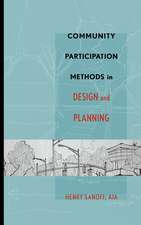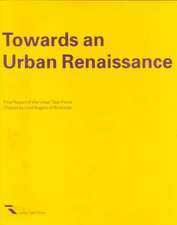Green Wedge Urbanism: History, Theory and Contemporary Practice
Autor Professor Fabiano Lemes de Oliveiraen Limba Engleză Paperback – 5 feb 2020
| Toate formatele și edițiile | Preț | Express |
|---|---|---|
| Paperback (1) | 223.98 lei 3-5 săpt. | +53.95 lei 7-13 zile |
| Bloomsbury Publishing – 5 feb 2020 | 223.98 lei 3-5 săpt. | +53.95 lei 7-13 zile |
| Hardback (1) | 775.83 lei 6-8 săpt. | +162.06 lei 7-13 zile |
| Bloomsbury Publishing – 22 feb 2017 | 775.83 lei 6-8 săpt. | +162.06 lei 7-13 zile |
Preț: 223.98 lei
Preț vechi: 249.02 lei
-10% Nou
Puncte Express: 336
Preț estimativ în valută:
42.86€ • 44.87$ • 35.46£
42.86€ • 44.87$ • 35.46£
Carte disponibilă
Livrare economică 15-29 martie
Livrare express 01-07 martie pentru 63.94 lei
Preluare comenzi: 021 569.72.76
Specificații
ISBN-13: 9781350154346
ISBN-10: 1350154342
Pagini: 304
Ilustrații: 87 bw illus
Dimensiuni: 156 x 234 x 23 mm
Greutate: 0.66 kg
Editura: Bloomsbury Publishing
Colecția Bloomsbury Visual Arts
Locul publicării:London, United Kingdom
ISBN-10: 1350154342
Pagini: 304
Ilustrații: 87 bw illus
Dimensiuni: 156 x 234 x 23 mm
Greutate: 0.66 kg
Editura: Bloomsbury Publishing
Colecția Bloomsbury Visual Arts
Locul publicării:London, United Kingdom
Caracteristici
Fills a gap in contemporary debates about urban green spaces - providing the first full account of 'green wedges' in urban planning
Notă biografică
Fabiano Lemes de Oliveira is Associate Professor in Urbanism at Politecnico di Milano. His research interests include urban design theory, modern architecture history and exploring the relationship between modern planning ideas and landscape architecture.
Cuprins
IntroductionGreen wedge: definitionsInterdisciplinarity, locality, temporality and scaleThe structureMethods and sourcesPart 1 - Green Wedges in HistoryChapter 1 - Urban planning with natureThe Enlightenment and the pursuit of natureThe industrial revolution and the disintegration of open spacesThe rise of town planningRing vs. radial growthPark systemsChapter 2 - The emergence and diffusion of the green wedge ideaRadial planning, radial parks and green wedgesIntrinsic opposition: belts vs. wedgesOpposition resolved: belts and wedges as elements of the same park systemThe socialist cityChapter 3 - Towards a bright future: green-wedge visions for the post-war periodLondon: the green-wedge metropolisDiagraming the futureThe County of London Plan 1943The Greater London Plan 1944Other British citiesNew towns and green spacesPlanning new beginningsChapter 4 - Polycentrism and regional planningOrganising the territory: the Nordic experienceThe 1947 Finger PlanOther Scandinavian capitalsThe corridor-wedge model: the Nordic influencePlanning the metropolis: the case of São PauloCorridor-wedge in the United StatesVisions for South East EnglandThe case of MelbourneOther casesThe Green Heart and wedges of Randstad in the NetherlandsPart 2 - Green Wedges TodayChapter 5 - Green spaces, networks and contemporary challengesThe benefits of green spacesThe birth of Urban Design and the 'Star City'Green infrastructuresLandscape EcologyLandscape UrbanismSustainability and resilience in face of climate changeChapter 6 - Towards sustainable and resilient city-regionsStockholm: towards blue and green wedgesThe development of a model: the Copenhagen Finger PlanThe green fingers of HelsinkiRandstad: from Green Heart to Green-Blue DeltaMelbourne towards 2030Freiburg: the green wedge and the mountain-valley systemsChapter 7 - Green wedges: from the city-region to the neighbourhoodHamburg green network planThe Raggi Verdi of MilanSongzhuang Arts and Agriculture City: a new form of urban-rural relationshipGreen wedges at multiple scales: ViikkiRieselfeldVaubanThe Neighbourhood scale: Dunsfold Park, UKThe green wedge as a typology: La Sagrera Linear Park, SpainGreen Wedge Urbanism: Past, Present and FutureThe green wedge idea: from the city scale to the polycentric regionTowards a theory of green wedge urbanismIndexBibliographyNotes
Recenzii
Green Wedge Urbanism provides an original and potentially impactful contribution to urban theory, history and practice. The narrative of the book surfaces the concept of the Green Wedge historically and geographically, acting both as an archaeology of its meaning and a critical examination of its contemporary practice.
This fascinating and historically informed account sheds new light on the urban landscape, reminding us of the benefits of linear open space, whether as an alternative to encompassing green belts or (even better) in combination with them.
A strong argument for the significance of the concept in planning history and practice. Overall, Lemes de Oliveira's chronicle of the green wedge concept adds significantly to our understanding of this impactful model. It will be useful for environmental and regional planners, particularly those with an interest in planning history or theory. . . . Appropriate for graduate-level courses.
The book provides new, scientifically sound information on the design of green corridors in numerous cities, past and present. . . . The book is very well suited as a textbook as well as a comprehensive study for anyone interested in urban and green space planning.
This fascinating and historically informed account sheds new light on the urban landscape, reminding us of the benefits of linear open space, whether as an alternative to encompassing green belts or (even better) in combination with them.
A strong argument for the significance of the concept in planning history and practice. Overall, Lemes de Oliveira's chronicle of the green wedge concept adds significantly to our understanding of this impactful model. It will be useful for environmental and regional planners, particularly those with an interest in planning history or theory. . . . Appropriate for graduate-level courses.
The book provides new, scientifically sound information on the design of green corridors in numerous cities, past and present. . . . The book is very well suited as a textbook as well as a comprehensive study for anyone interested in urban and green space planning.












